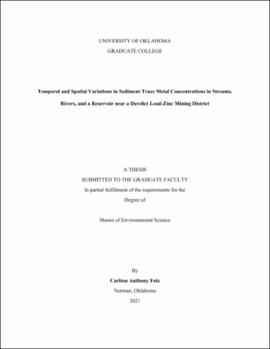| dc.description.abstract | Historic lead and zinc mining in the Tri-State Mining District has ceased, but the legacy of
trace metal contamination (Cd, Cu, Ni, Pb, and Zn) throughout the region still exists. This thesis
focuses on stream sediments in and downstream from contaminated areas. This study evaluated
temporal changes of trace metal concentrations over 35-years in Tar Creek sediments. The spatial
distribution of trace metal concentrations was subject to analyses between Tar Creek, the Neosho
River, the Spring River, and Grand Lake O’ the Cherokees. The last study focused on the
bioavailability of trace metals in sediments and what factors may influence it. The watershed of
Grand Lake O’ the Cherokees drains multiple National Priority List Superfund sites from miningrelated activities. Sources of trace metals entering the surface water systems include artesian
flowing mine drainage, mining waste pile leachate, and mine waste in the active channels.
When evaluating temporal changes in Tar Creek sediments, Cd, Mn, Ni, and Zn
concentrations and organic carbon content increased. At the same time, Fe, Pb, and S decreased
from 1985 to 2020. Spatially, Cd, Pb, and Zn concentrations decreased with increasing distance
from mining impaired areas. Lastly, evaluating the impact of sediment pH, sediment organic
carbon, and total Fe concentrations resulted in a wide range of responses and variability. The
bioavailable concentrations of trace metals were not influenced equally by these factors. Use of
statistical evaluations at the 95th confidence interval for the appropriate tests allowed for the
determination of significance. Sediment-bound trace metals in freshwater sediments have complex
behaviors and are becoming distributed downstream of the mining district. As remediation of
sediments in the Superfund sites begins, it is imperative to understand the sources, mobility, and
bioavailability of the trace metals to increase the effectiveness and efficiency of remediation while
minimizing potential human and environmental risks. | en_US |
